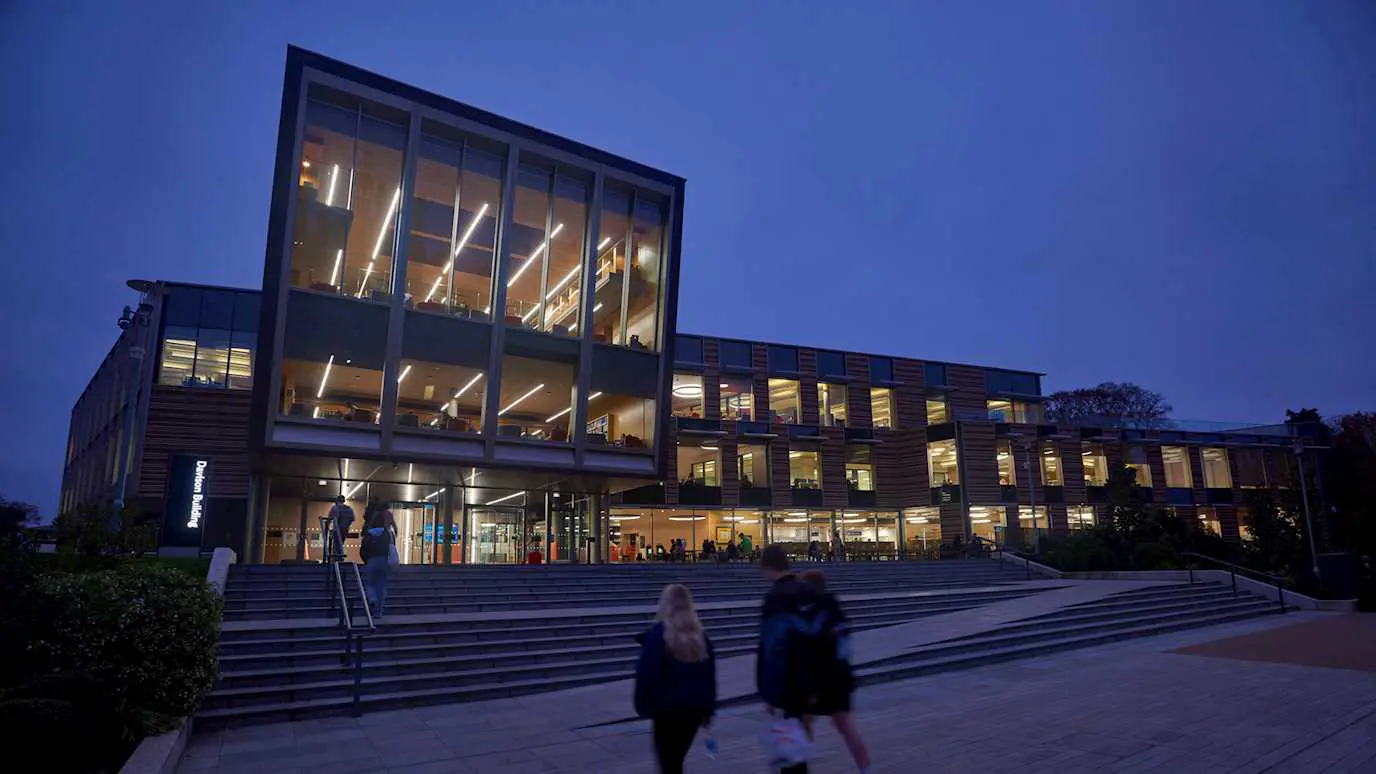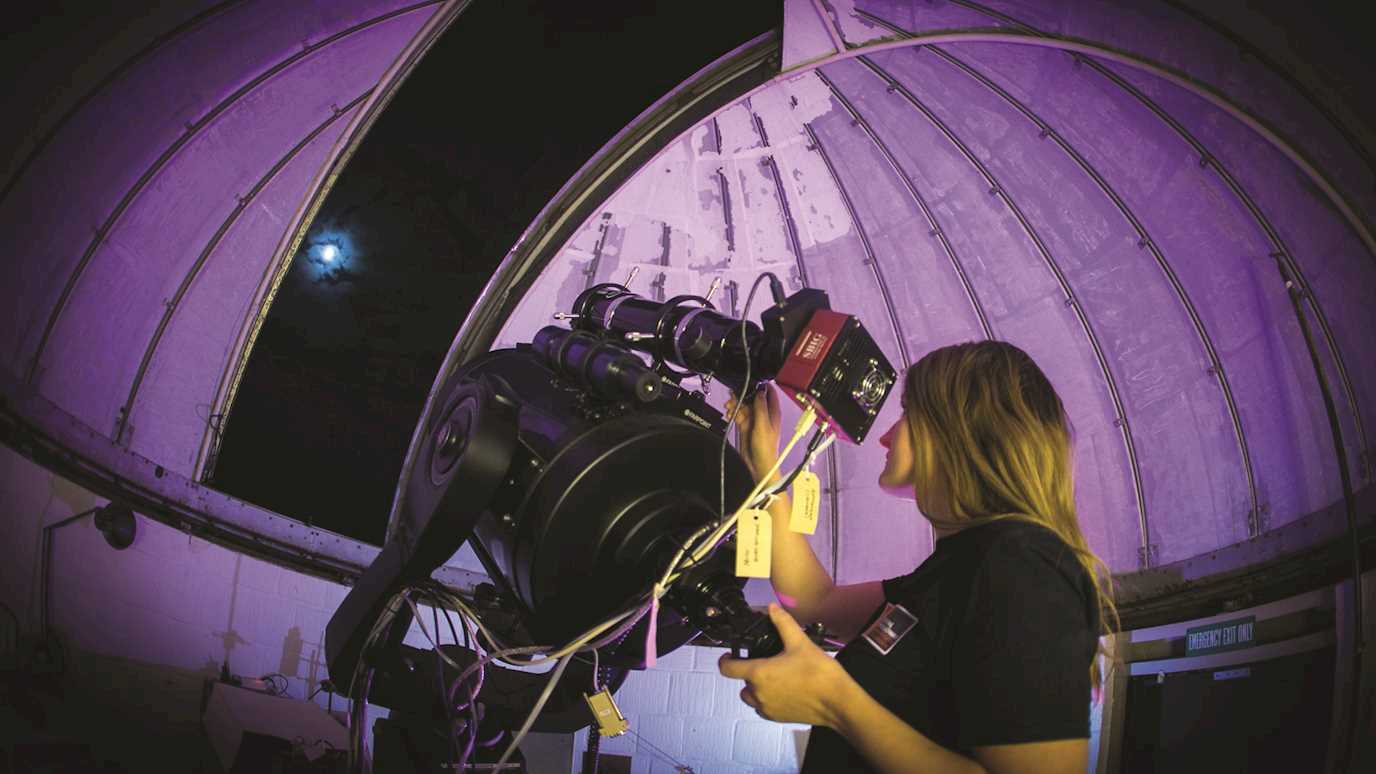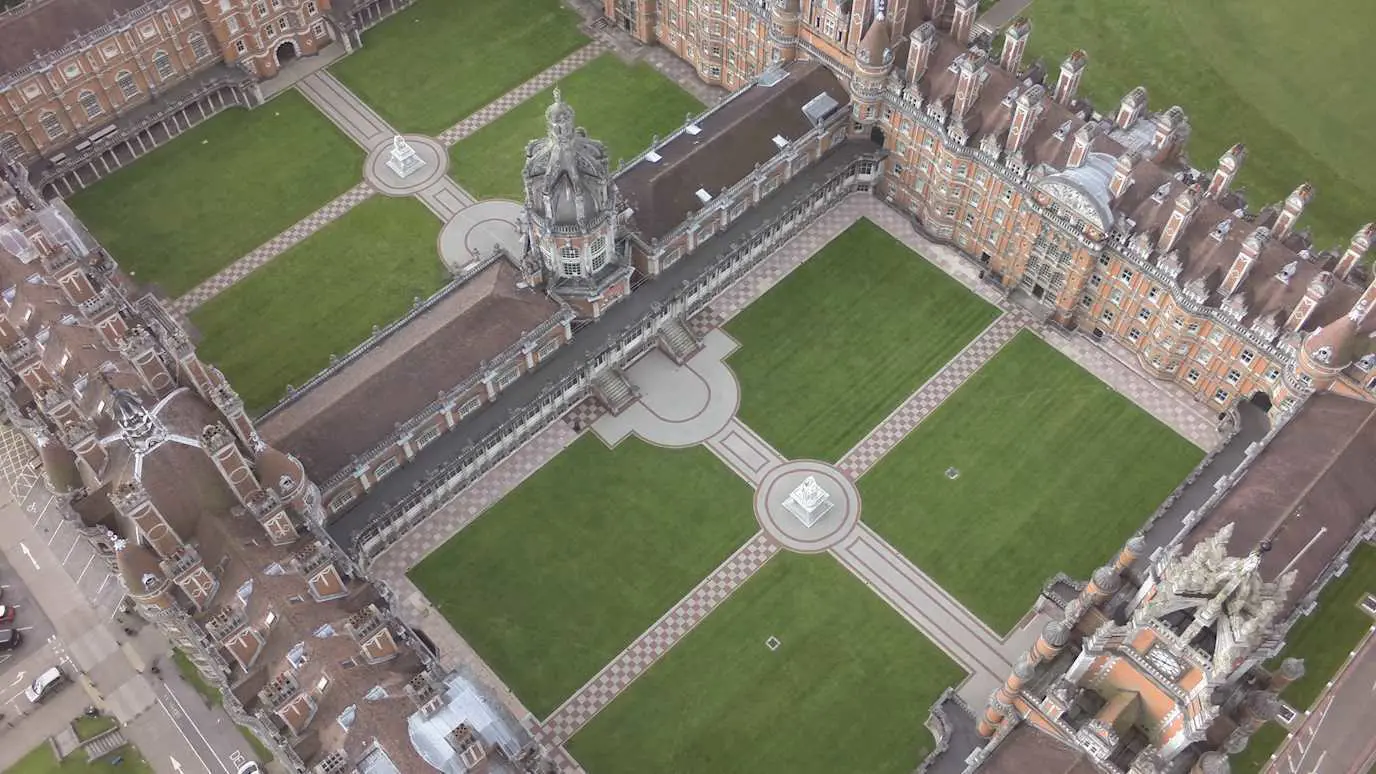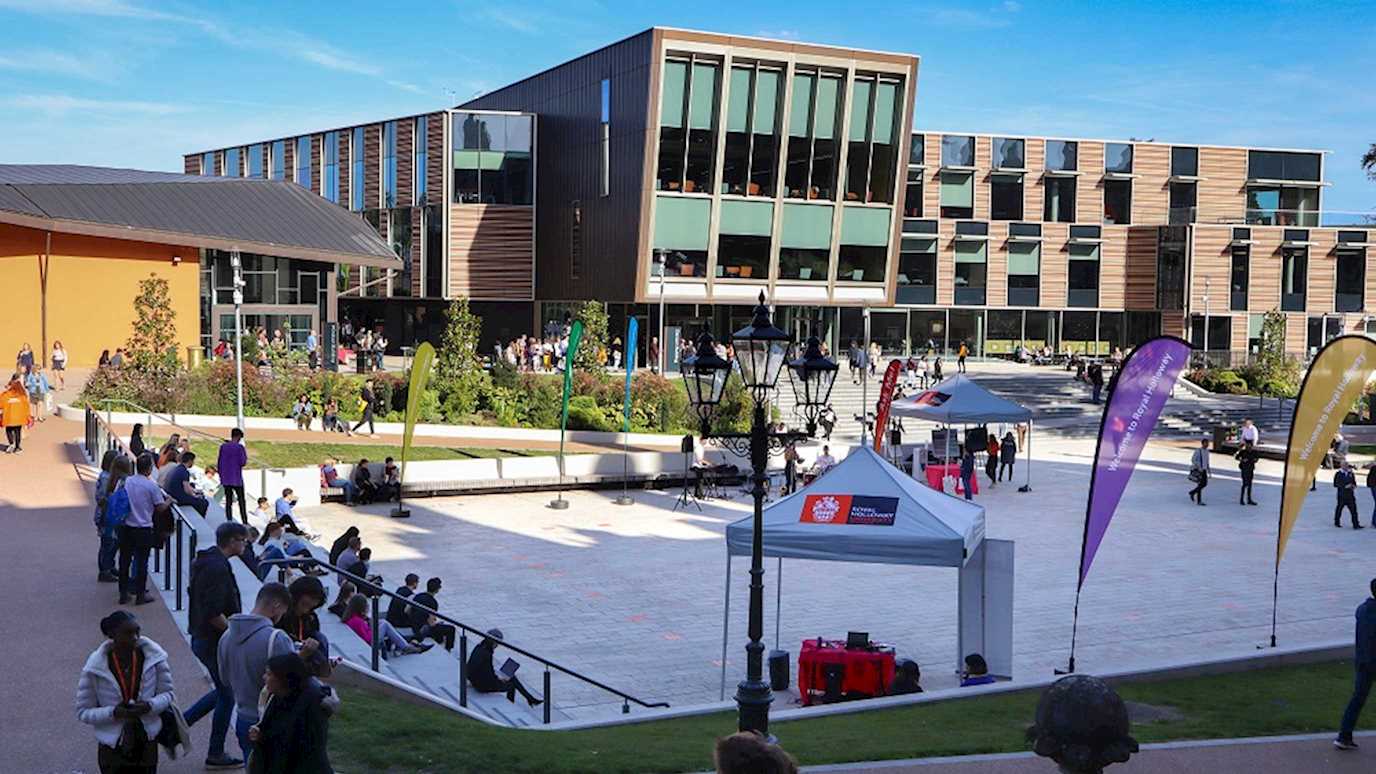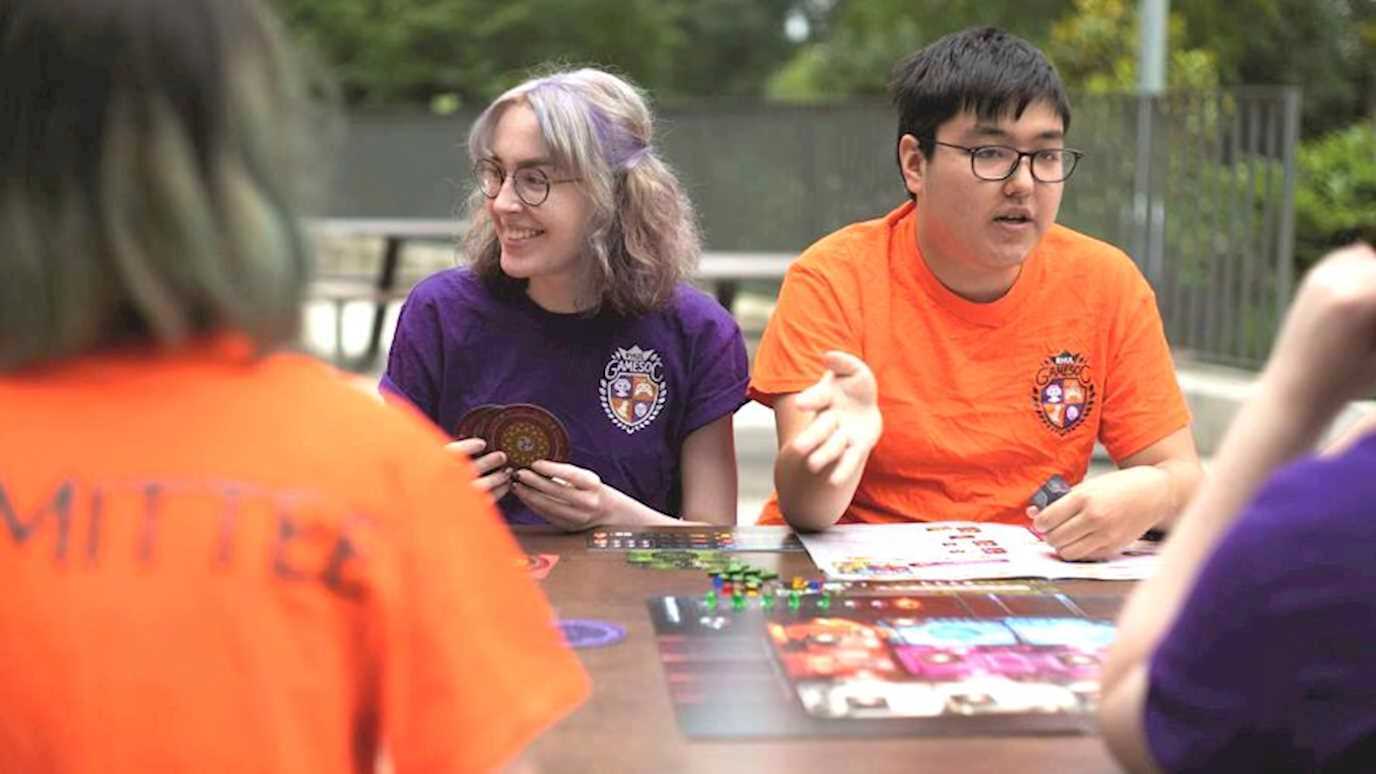Course options
Key information
Duration: 4 years full time
UCAS code: F303
Institution code: R72
Campus: Egham
The course
Physics (MSci)
Our students often say their enthusiasm to study Physics stems from wanting to learn more about the Higgs particle, dark matter, nanotechnology or just a wide-ranging curiosity about how things really work. Whatever your reasons, our Physics department aims to inform and excite you in the study of Physics, the most fundamental of the sciences.
As one of the most respected centres for Physics teaching and research in the UK, you will join a vibrant environment, where you can pursue your studies and plan your future career.
On our four-year MSci course, we’ll cover the core material that a graduate physicist would be expected to know, including quantum mechanics, electromagnetism, statistical physics and thermodynamics, Einstein’s relativistic physics and the study of the fundamental structure of matter and the universe. You’ll also develop the mathematical, experimental and conceptual knowledge and skills to a more advanced level.
Your fourth year is intercollegiate, which means you can pick choices from other University of London colleges – modules can include Quantum Computation, Nanoscale Physics and others. You’ll also develop experimental, conceptual and observational skills from your final year Major Project, which will make you an attractive candidate in a range of sectors, including management and finance, as well as scientific, technical, engineering and teaching careers.
We’re based at the heart of the campus, where you’ll have access to laboratories, technical help, academic staff and, on the roof of the department, our astronomical dome. In Egham, Surrey, we’re well away from the light pollution of the big city so our telescopes can give you the best observational astronomy in the University of London. Beyond the specialist equipment, we also have video-conferencing facilities that allow people to take part in seminars and lectures at other institutions.
- Research is expanding in new and exciting directions, plus strategic partnerships such as CERN and the National Physical Laboratory (NPL), SNOLAB and with industry, and there are impressive research facilities in the Physics labs with dedicated technical help.
- We put a real emphasis on small group teaching – a close-knit, friendly and supportive environment with high staff-student ratio and an open door policy.
- We enjoy a strong track record of high student satisfaction in the annual National Student Survey.
- We’ve been awarded IOP Juno Champion and Athena SWAN silver awards for best practice in equality, promoting women in science and welcoming large cohorts of female students.
- This course is fully accredited by the Institute of Physics (IOP)
- A wide range of fourth-year options taught across the University of London physics consortium, providing access to world-leading experts.
- Extended research project embedded within a research group, working directly with your personal academic supervisor.
- Final year builds on the core physics content allowing you to gain specialist knowledge in your chosen area of interest.
We sometimes make changes to our courses to improve your experience. If this happens, we’ll let you know as soon as possible.
Course structure
Core Modules
Year 1
-
In this module you will develop an understanding of how to solve problems involving one variable (either real or complex) and differentiate and integrate simple functions. You will learn how to use vector algebra and geometry and how to use the common probability distributions.
-
In this module you will develop an understanding of how to solve problems involving more than one variable. You will learn how to use matrices and solves eigenvalue problems, and how to manipulate vector differential operators, including gradient, divergence and curl. You will also consider their physical significance and the theorems of Gauss and Stokes.
-
In this module you will develop an understanding of good practices in the laboratory. You will keep a notebook, recording experimental work as you do it. You will set up an experiment from a script, and carry out and record measurements. You will learn how to analyse data and plot graphs using a computer package, and present results and conclusions including error estimations from your experiments.
-
In this module you will develop a range of skills in the scientific laboratory. You will learn how to use the Mathematica algebra software package to solve simple problems and carry out a number of individually programmed physics experiments. You will also work as part of a team to investigate an open-ended computational problem.
-
In this module you will develop an understanding of how to apply the techniques and formulae of mathematical analysis, in particular the use of vectors and calculus, to solve problems in classical mechanics. You will look at statics, dynamics and kinematics as applied to linear and rigid bodies. You will also examine the various techniques of physical analysis to solve problems, such as force diagrams and conservation principles.
-
In this module you will develop an understanding of how electric and magnetic fields are generated from static charges and constant currents flowing through wires. You will derive the properties of capacitors and inductors from first principles, and you will learn how to analyse simple circuits. You will use complex numbers to describe damped harmonic oscillations, and the motion of transverse and longitudinal waves.
-
In this module you will develop an understanding of the macroscopic properties of the various states of matter, looking at elementary ideas such as ideal gases, internal energy and heat capacity. Using classical models of thermodynamics, you will examine gases, liquids, solids, and the transitions between these states, considering phase equilibrium, the van der Waals equation and the liquefaction of gases. You will also examine other states of matter, including polymers, colloids, liquid crystals and plasmas.
-
In this module you will develop an understanding of the building blocks of fundamental physics. You will look at Einstein’s special theory of relativity, considering time-dilation and length contraction, the basics of quantum mechanics, for example wave-particle duality, and the Schrödinger equation. You will also examine concepts in astrophysics such as the Big Bang theory and how the Universe came to be the way we observe it today.
-
This module will describe the key principles of academic integrity, focusing on university assignments. Plagiarism, collusion and commissioning will be described as activities that undermine academic integrity, and the possible consequences of engaging in such activities will be described. Activities, with feedback, will provide you with opportunities to reflect and develop your understanding of academic integrity principles.
Year 2
-
In this module you will develop an understanding of the mathematical representation of physical problems, and the physical interpretation of mathematical equations. You will study both ordinary and partial differential equations, and learn about their properties: linear, order, homogeneous and inhomogeneous. You will learn to solve partial differential equations using the separation of variables method, and solve Laplace's equation in Cartesian, polar and spherical coordinates. Solutions will involve application of sines and cosines, Legendre polynomials, Bessel's equation, and the Sturm–Liouville theorem. In addition, you will become familiar with the Dirac delta function, the Gamma function, and Fourier transforms.
-
In this module you will develop an understanding of how computers are used in modern science for data analysis and visualisation. You will be introduced to the intuitive programming language, Python, and looking at the basics of numerical calculation. You will examine the usage of arrays and matrices, how to plot and visualise data, how to evaluate simple and complex expressions, how to sample using the Monte Carlo methods, and how to solve linear equations.
-
In this module you will develop an understanding of quantum mechanics and its role in and atomic, nuclear, particle and condensed matter physics. You will look at the wave nature of matter and the probabilistic nature of microscopic phenomena. You will learn how to use the key equation of quantum mechanics to describe fundamental phenomena, such as energy quantisation and quantum tunnelling. You will examine the principles of quantum mechanics, their physical consequences, and applications, considering the nature of harmonic oscillator systems and hydrogen atoms.
-
This module will consolidate the core laboratory components from other modules to create a coherent, stand-alone course designed to build your lab experience with more specialist support, enabling you to engage better with course material.
-
In this module you develop an understanding of the properties of light, starting from Maxwell’s equations. You will look at optical phenomena such as refraction, diffraction and interference, and how they are exploited in modern applications, from virtual reality headsets to the detection of gravitational waves. You will also examine masers and lasers, and their usage in optical imaging and image processing.
-
In this module you will develop an understanding of how James Clerk Maxwell unified all known electrical and magnetic effects with just four equations, providing Einstein’s motivation for developing the special theory of relativity, explaining light as an electromagnetic phenomenon, and predicting the electromagnetic spectrum. You examine these equations and their consequences, looking at how Maxwell’s work underpins all of modern physics and technology. You will also consider how electromagnetism provides the paradigm for the study of all other forces in nature.
-
In this module you will develop an understanding of thermal physics and elementary quantum mechanics. You will look at the thermodynamic properties of an ideal gas, examining the solutions of Schrödinger’s equation for particles in a box, and phenomena such as negative temperature, superfluidity and superconductivity. You will also consider the thermodynamic equilibrium process, entropy in thermo-dynamics, and black-body radiation.
-
In this module you will develop an understanding of the physical properties of solids. You will look at their structure and symmetry, concepts of dislocation and plastic deformation, and the electrical characteristics of metals, alloys and semiconductors. You will examine methods of probing solids and x-ray diffraction, and the thermal properties of photons. You will also consider the quantum theory of solids, including energy bands and the Bloch theorem, as well as exploring fermiology, intrinsic and extrinsic semiconductors, and magnetism.
Year 3
-
This module builds on skills developed in the second year to prepare you for the final year project and beyond. You will plan and carry out three assignments: the first introduces advanced data analysis techniques, and the second is a group project. Through the mini-project, you will be introduced to some of the research activities within the Department and to the methods of working within the groups. There are opportunities to practise important skills such as report writing and giving oral presentations.
-
This module introduces a more advanced level of quantum theory than experienced in earlier years. Here you will understand and use the bra–ket (Dirac) notation for quantum states, understand and use the vector space and matrix representation of operator formalism, expansion of any states in terms of some complete set, the ladder operator approach to the harmonic oscillator, and generalise the definition of angular momentum to include spin and solve the generalised angular momentum eigenvalue problem employing raising and lowering operator techniques. You will cover the properties of spin-1/2 systems and use the Pauli matrices to solve simple problems, understand the concept and consequences of identical particles for fermions and bosons, and state the rules for the addition of angular momenta and outline the underlying general mathematical arguments, applying them in particular to two spin-1/2 particles. Finally, you will formulate first-order and second-order time-independent perturbation theory and apply it to some simple examples; formulate the variational and WKB methods and apply them to some simple systems; and formulate first-order and second-order time-dependent perturbation theory. From this, you will show, as an example, how it can lead to Fermi's Golden Rule.
Year 4
-
In this module you will carry out a major individual research project, forming a significant part of your final year in the MSci programme. Your project may be experimental, theoretical or computational, and will be closely linked to the department's research activity. You will gain experience in planning and managing a substantial piece of scientific work, and develop skills in research techniques, data analysis and presentation. You will also learn the value of collaboration and teamwork in scientific environments. The module culminates in a detailed project report that showcases your work and can support future applications in industry or academia.
-
In this module you will explore a topic related to current research in physics through independent study. You will investigate original scientific papers, develop a strong understanding of the chosen subject, and produce a well-structured written report with appropriate references. Through this process, you will improve your research, organisational and presentation skills, as well as develop greater confidence in working independently and engaging with advanced scientific literature.
Optional Modules
Below is a taster of some of the exciting optional modules that students on the course could choose from during this academic year. Please be aware these do change over time, and optional modules may be withdrawn or new ones added.
Year 1
-
All modules are core
Year 2
-
All modules are core
Year 3
-
This module introduces you to advanced topics and methods in classical physics (including mechanics, electromagnetism and relativity). You will cover the Calculus of Variations including the Euler-Lagrange equation, constraints and the method of Lagrange multipliers; non-relativistic classical physics through the principle of stationary action and Lagrangian mechanics, integration of the equation of motion in one dimension, motion in a non-inertial reference frame, Hamiltonian mechanics, symmetries, constants of motion and conservation laws, canonical transformations and Liouville's theorem; the module will end with a dive into relativitstic physics covering the principle of relativity and relativistic formalism, Lagrangian of a charged particle in an electromagnetic field, equations of motion of a charged paritcle in an EM field and gauge invariance, electromagnetic field tensor, relativistic invariants of the field, covariant formulation of the Lorentz force and Maxwell's equations.
-
This module introduces you to the mathematical areas of complex analysis, matrix theory and linear transformations, and group theory, and enables you to apply related advanced mathematical formalisms and methods to formulate and solve physics problems. In the complex analysis section, you will cover holomorphic functions, power series, logarithms, isolated singular points, complex integration, Cauchy’s theorem and integral formula, Laurent series, Cauchy’s residue theorem, and applications of contour integration. For the matrix theory and linear transformations topic, you will cover the fundamentals of matrix theory, unitary diagonalisation, vector spaces and linear transformations, matrix representations, equivalence and similarity, inner product, norm, orthonormal bases, dual space and bra–ket notation. For the final chapter, you will cover the fundamentals of group theory, crystal lattice symmetries, Lie groups and Lie algebra, reducible and irreducible group representations.
-
This module introduces you to the fundamentals of the analysis of non-linear dynamical systems and, in particular, investigates whether the behaviour of a non-linear system can be predicted from the corresponding linear system. You will cover systems of first-order linear differential equations, similarity types for matrices and their connection with linear systems, the classification of two-dimensional linear phase portraits with extension to three dimensions, non-linear differential equations through Liapunov’s stability analysis, periodic solutions and limit cycles, and the Poincaré–Bendixson theorem, as well as applications to problems from physics, biology and economics. You will also cover non-linear difference equations, Poincaré surface of section, stability of critical points, and routes to chaos.
-
This module introduces a more advanced level of quantum theory than experienced in earlier years. Here you will understand and use the bra–ket (Dirac) notation for quantum states, understand and use the vector space and matrix representation of operator formalism, expansion of any states in terms of some complete set, the ladder operator approach to the harmonic oscillator, and generalise the definition of angular momentum to include spin and solve the generalised angular momentum eigenvalue problem employing raising and lowering operator techniques. You will cover the properties of spin-1/2 systems and use the Pauli matrices to solve simple problems, understand the concept and consequences of identical particles for fermions and bosons, and state the rules for the addition of angular momenta and outline the underlying general mathematical arguments, applying them in particular to two spin-1/2 particles. Finally, you will formulate first-order and second-order time-independent perturbation theory and apply it to some simple examples; formulate the variational and WKB methods and apply them to some simple systems; and formulate first-order and second-order time-dependent perturbation theory. From this, you will show, as an example, how it can lead to Fermi's Golden Rule.
-
In this module you will develop an understanding of the physics of elementary particles and their interactions, as well as experimental techniques to study these. Topics include the simple quark model, leptons and lepton numbers, strange particles, heavy quarks, quantum numbers, electroweak unification, W and Z bosons, the Higgs mechanism, and QCD. Energy loss processes, particle detectors, accelerators, and spin-off applications will also be studied. Extended topics explore deep inelastic scattering, supersymmetry, beyond the Standard Model, dark matter, neutrino oscillations, and applications to industry and medicine.
-
This module covers the theory of electrons in metals and semiconductors, focusing on electronic structure, transport, and collective excitations. Topics include electrons in periodic potentials, nearly free and tight-binding models, bandwidth, effective mass, holes, and band structures of materials such as Si, Ge and GaAs. It also examines intrinsic and extrinsic semiconductors, charge transport via the Drude and semiclassical models, and electron response to electric and magnetic fields. Finally, it explores optical properties, particle–hole excitations, plasma oscillations, and screening in metals.
-
In this module you will develop an understanding of the core principles and mathematics of general relativity. You will learn how gravity arises from the curvature of spacetime, and explore the equivalence principle and tensor analysis in flat and curved spaces. You will study Einstein’s field equations in both vacuum and matter-filled spacetimes, and apply them to phenomena such as gravitational redshift, light bending, black holes, cosmology and gravitational waves. You will also gain practical experience in manipulating tensors and solving equations of motion in simple gravitational systems.
-
In this module you will develop an understanding of the physical principles that govern the structure and evolution of stars. You will learn how observational data such as luminosity, temperature, spectra, mass and radius are used to study stellar properties. You will explore the physics of stellar interiors and atmospheres, including energy generation and transport through radiation and convection. You will study the different stages in the life of a star, from formation to supernovae and nucleosynthesis, and consider the role of the interstellar medium. You will also perform simplified calculations and estimations, and examine how theoretical models compare with observational results.
-
In this module you will develop an understanding of the connection between particle physics and cosmology. You will review the Standard Model and learn how to use Feynman diagrams to estimate cross-sections and decay rates. You will study the early universe through the Friedmann equations, exploring topics such as primordial nucleosynthesis, the cosmic microwave background, and the matter–antimatter imbalance. You will also examine the role of dark matter and inflation in cosmic evolution. Additional topics include the origin and detection of cosmic rays and the behaviour of neutrinos in astrophysical environments. You will gain experience in making order-of-magnitude estimates and solving problems related to processes in the early universe.
-
In this module you will develop an understanding of the structure and evolution of the Solar System, with a focus on the physical and chemical properties of planetary bodies. You will study the formation of the Solar System and explore the processes that shape planetary surfaces, including impact cratering, volcanism, tectonism and erosion. You will examine planetary interiors and atmospheres, and learn how to interpret remote sensing data using techniques from geology, geophysics and geochemistry. The module also includes a detailed study of the Earth–Moon system, terrestrial and giant planets, planetary satellites, comets and meteorites. You will learn to evaluate scientific data, test hypotheses, and communicate key findings from planetary science and space missions.
-
In this module you will develop an understanding of astronomy, and observations of different wavelengths. You will look at the merits and limitations of earth and space-based telescopes, and consider key concepts, including coordinate systems, timekeeping systems, brightness measurement, distance, colour, temperature and spectrum. You will also examine the contents of the solar system, including the planets and their moons, rings, asteroids, comets, dust and the solar wind.
-
This module aims to give students an overall view of the generation, transmission, storage and usage of energy (conventional and renewables). This course also examines the relationship between energy production, politics, economics and environmental pollution, particularly as regards to global warming.
Course Content:
Generation, transmission, storage and supply of energy. Conventional energy sources: fossil fuels and nuclear fission. Renewable sources of energy: fusion, hydroelectric, solar-thermal and solar-electric, wind, wave and tidal. Physics of the climate: energy and radiation, greenhouse effect, climate models, global warming. Experimental methods for measuring global temperatures and greenhouse gas emissions. Choice of an energy source for the UK taking into account technical, economic, political and environmental considerations. -
On this module you'll learn to apply the principles of quantum mechanics (developing on from courses PH2210, PH3210) to many electron atomic systems; To build quantitative models to understand and predict the behaviour of multi-electron atoms, which were introduced qualitatively in PH1920; To understand experimental spectroscopy techniques and compare with model predictions.
Course Content: Atomic transitions and selection rules. Transitions rates. Natural broadening of transition lines. Coupling to a continuum. Fermi golden rule. Doppler and collisional broadening.Magnetic properties of the atom. Magnetic dipole associated to orbital motion and to spin. Zeeman and Stark effects. Relativistic corrections and fine structure, in particular spin orbit interaction. Effect of the nucleus spin: hyperfine structure. Atomic clocks. Metrology of the hydrogen atom. Multi electron atoms. Effect of exchange interaction. Example of He.Effect of Coulomb interactions, mean field approximation (Hartree), self-consistent potential. Applications to the ground state of the multi-electron atom. Applications to the excited states of the multi-electron atom: optical transitions and Xray transitions.Spectroscopic notation. Multiplets. Landé interval rule.Introduction of the quantum model of the interaction between light and matter. Coupling to a quantized mode. Applications to quantum optics.Extension of atomic physics concepts to nuclear and molecular physics
Year 4
-
This module introduces advanced topics and methods used in classical physics (mechanics, electromagnetism, relativity) and develops skills in applying these methods.
The course introduces students to the methods of Calculus of Variations and their application in the Lagrangian and Hamiltonian treatment of nonrelativistic and relativistic Classical Mechanics including aspects of the dynamics of charged particles and electromagnetic fields. It enables students to apply variational methods and to use the Lagrangian/Hamiltonian formalism to solve related problems in Classical Physics. More specifically, the following topics are covered: Calculus of Variations: Euler-Lagrange equation; constraints and the method of Lagrange multipliers; Nonrelativistic Classical Physics: principle of stationary action and Lagrangian mechanics; integration of the equation of motion in one dimension; motion in a noninertial frame of reference; Hamilton equations and Hamiltonian mechanics; symmetries, constants of motion and conservation laws; canonical transformations and Liouville theorem; Lagrangian of charged particle in electromagnetic (EM) field; equation of motion of charged particle in EM field and gauge invariance; Relativistic Classical Physics: principle of relativity and relativistic formalism; four-potential of the EM field and EM field tensor; Lorentz transformation and invariants; covariant formulation of the Lorentz force and Maxwell equations; outlook: classical field theory and Noether theorem. M-Level: Lorentz covariance: four-tensor formalism for relativistic physical laws, covariant formulation of Maxwell's equations and the Lorentz force, introduction to classical field theory and Noether's theorem -
In this module you will develop a deeper understanding of the mathematical formalism of quantum mechanics, including the use of density operators, evolution operators and different representations of quantum dynamics. You will explore the role of symmetry and conservation laws in quantum systems, focusing on translations, parity and rotations. The module introduces semiclassical methods such as the Wentzel–Kramers–Brillouin approximation for solving the Schrödinger equation in one dimension. You will study the physics of identical particles and learn the basics of second quantisation, a key tool in many-particle quantum theory. The concept of quantum entanglement is introduced, along with its fundamental implications. The module also covers selected advanced topics, such as Feynman path integrals and quantum scattering, providing insight into the foundations and applications of modern quantum theory.
-
In this module you will develop an understanding of quantum field theory through the study of relativistic wave equations and field quantisation. You will begin with an introduction to the Lorentz group and four-vector notation, followed by a review of classical field theory using relativistic formalism and Noether’s theorem. You will explore scalar fields through the Klein–Gordon equation and then move on to canonical quantisation of free scalar fields, introducing commutators, time-ordered products and the Feynman propagator. The module also covers classical spinor fields and the Dirac equation, including its symmetries, solutions and interaction with electromagnetic fields. You will study interacting quantum field theories using the interaction picture and S-matrix, and learn how to apply Feynman rules to calculate tree-level diagrams for particle decays and scattering processes.
-
In this module you will develop a detailed understanding of the mathematical framework of the Standard Model of Particle Physics. You will study the relativistic wave equations that describe fundamental particles, including the Klein–Gordon and Dirac equations, and explore their symmetries and physical interpretations. You will learn how to apply Feynman diagrams and perturbation theory to calculate cross-sections and decay rates for high-energy processes. The module covers the development of the Standard Model through quantum electrodynamics, weak interactions, and electroweak unification, including the Higgs mechanism. You will also study quantum chromodynamics, colour charge, parton models and the physics of hadron colliders. The theoretical tools developed in the course are used to compute predictions for key particle reactions, and these are compared with experimental results.
-
This module introduces you to particle accelerator physics, starting with the history of accelerators and their basic principles, including centre-of-mass energy, luminosity and the accelerating gradient. You will then cover the characteristics of modern accelerators and colliders, such as LEP, the LHC, and b-factories. Focus will then shift to the propagation of particle beams and bunches, how they behave and how they are controlled, covered through topics on transverse motion, principles of beam cooling, strong focusing, simple lattices, circulating beams, synchrotron radiation, and longitudinal dynamics. You will learn about accelerating structures such as radio-frequency cavities and how superconductivity is applied in particle acceleration. You will cover contemporary applications of accelerators as light sources and their medical uses before moving on to discussions of the future of accelerators and colliders, including the ILC, neutrino factories, muon colliders, and laser plasma acceleration.
-
The purpose of this module is to provide an introduction to the theory and applications of quantum many-body systems. The module will focus primarily on systems at or close to equilibrium, with a view towards non-equilibrium quantum systems.
-
In this module you will explore the rapidly advancing field of nano-electronic devices, with a focus on their applications in quantum computation and metrology. You will study low-dimensional electronic transport in systems such as two-dimensional electron gases, quantum wires and quantum dots, and examine phenomena including ballistic conduction, Landau levels and the Quantum Hall effect. The module covers tunnel junction devices such as single-electron transistors and Josephson junctions, and their roles in defining quantum standards of resistance, voltage and current. You will also study quantum devices based on two-level systems, including transmon qubits and superconducting circuits, and gain insight into quantum coherence and control. In addition, the module introduces nano-fabrication techniques such as lithography, deposition and etching, alongside nano-analysis methods using scanning probe and electron microscopy, and spectroscopic tools.
-
Superconductors demonstrate remarkable macroscopic quantum behaviour and underpin quantum technologies. This module introduces the superconductivity in the context of the more general phenomenon of superfluidity, presents the unique electrical, magnetic and thermodynamic properties of the superconductors in conjunction with phenomenological theory and technological applications, and discusses the microscopic physics that leads to the superconductivity and various classes of superconducting materials.
-
In this module you will develop a solid foundation in probability and statistical methods used in the analysis of experimental data in physics. You will learn key concepts such as random variables, probability density functions, expectation values and error propagation. The module introduces the Monte Carlo method, including random number generation, transformation techniques and Markov Chain Monte Carlo. You will study statistical testing using both frequentist and Bayesian approaches, exploring significance tests, p-values, and the treatment of nuisance parameters. You will also learn methods for parameter estimation, such as maximum likelihood, least squares and Bayesian inference. Through these tools, you will gain the skills needed to analyse and interpret data in modern physics research.
-
The module will focus on cosmology and gravitational and high-energy physics in the context of the early Universe. The standard cosmological model will be developed, the need for inflation and the various inflationary models will be studied in depth, and baryogenesis, leptogenesis and nucleosynthesis will be discussed. Spontaneously broken symmetries and the formation of topological defects will be covered, with the physics of topological defects—particularly cosmic strings—explored in detail. The hot topics of dark matter and dark energy will also be examined, along with the origin of large-scale structure and cosmic microwave background temperature anisotropies.
-
This module introduces students to the data analysis of gravitational-wave astronomy. The module begins with short general background of the field: the theory of gravitational waves, interferometric detectors, and gravitational-wave sources. Then, in turn it covers the topics of gravitational-wave data, source modelling, searching for signals, and estimating the parameters of the signals. For each topic, the basic data analysis theory is covered with examples. Following this, the module then turns to the astrophysical implications of the discoveries to date: cosmological measurements of the expansion rate of the Universe and searches for evidence of beyond-General Relativity physics.
-
Dark matter and dark energy make up 95% of the energy content of the Universe. This course takes a research- and literature-focused view, covering astrophysics and theoretical physics, with a coding element. It begins with astrophysical and cosmological evidence for dark matter and dark energy, from rotation curves of galaxies, gravitational lensing and the large-scale structure of the Universe. It then focuses on theories of dark matter, including WIMPs, axions and primordial black holes. Each of these types of dark matter can be searched for, and the main channels of direct and indirect detection are introduced.
-
This module introduces you to the mathematical areas of complex analysis, matrix theory and linear transformations, and group theory, and enables you to apply related advanced mathematical formalisms and methods to formulate and solve physics problems. In the complex analysis section, you will cover holomorphic functions, power series, logarithms, isolated singular points, complex integration, Cauchy’s theorem and integral formula, Laurent series, Cauchy’s residue theorem, and applications of contour integration. For the matrix theory and linear transformations topic, you will cover the fundamentals of matrix theory, unitary diagonalisation, vector spaces and linear transformations, matrix representations, equivalence and similarity, inner product, norm, orthonormal bases, dual space and bra–ket notation. For the final chapter, you will cover the fundamentals of group theory, crystal lattice symmetries, Lie groups and Lie algebra, and reducible and irreducible group representations.
-
In this module you will deepen your understanding of statistical mechanics and its application to both equilibrium and non-equilibrium systems. You will review core concepts such as the grand canonical ensemble and distribution functions for bosons and fermions. The module explores weakly interacting systems through the virial expansion and models like the imperfect and van der Waals gases, and introduces mean field theory for magnetic systems. You will examine strongly interacting systems and the nature of phase transitions, studying models such as the Ising model and Landau theory, and learn to distinguish between first- and second-order transitions. Topics such as broken symmetry, Goldstone bosons and critical fluctuations will be covered. The module concludes with an introduction to dissipative systems, including the fluctuation–dissipation theorem, Langevin dynamics and correlation functions, providing insight into how systems evolve towards equilibrium.
-
In this module you will build on previous knowledge to develop a deeper understanding of advanced astrophysics, preparing you for independent research. You will study radiative processes in astrophysical environments, including radiative transfer, interaction of radiation with matter, optical depth and thermal emission. Key concepts such as radiative flux, specific intensity and Eddington luminosity will be explored, along with mechanisms like Thomson scattering and Bremsstrahlung. The module also covers astrophysical fluid dynamics, examining the behaviour of collisional and collisionless fluids, conservation laws, pressure forces and gravitational effects through the virial theorem and Poisson’s equation. You will analyse fluid instabilities and apply mathematical tools to interpret and model radiative and dynamical processes in a variety of astrophysical settings
-
In this module you will explore key theoretical and practical aspects of modern photonic technologies, with a focus on emerging trends in nanophotonics and their real-world applications. You will study the physics underlying technologies such as lasers, plasmonics, metamaterials, biosensing and bio-imaging. The module introduces both fundamental and advanced concepts in photonics, helping you understand how light interacts with matter at micro- and nano-scales. You will apply these concepts to solve model problems, develop skills in analytical and numerical methods, and work effectively in group settings. By the end of the module, you will be able to relate photonic principles to cutting-edge technologies used in research, industry and healthcare.
-
In this module you will explore the atomic-scale structure and excitations of condensed matter, gaining insight into the physical principles that govern a wide range of materials. You will study the structure of crystalline materials using reciprocal space and scattering theory, including X-ray and neutron techniques, and learn how to interpret experimental data through concepts such as the Laue condition and Ewald construction. The module covers lattice vibrations, phonons and anharmonic interactions, with applications to both one-dimensional and three-dimensional systems. You will also examine magnetism in solids, including magnetic moments, ordering, and excitations including spin-density waves and crystal field effects. The module includes a study of phase transitions and critical phenomena using models such as Landau theory and the Ising model. You will explore local structural order in liquids and amorphous solids, and be introduced to key spectroscopic tools and sources such as synchrotrons and neutron facilities, supported by a visit to a national research centre.
-
In this module you will study the quantum mechanical modelling of materials at the nanoscale. You will explore key theoretical methods such as Density Functional Theory, Hartree-Fock, molecular dynamics and Monte Carlo techniques. The course focuses on how these tools are used to understand and predict properties of complex systems.
-
In this module you will explore advanced topics in condensed matter physics, focusing on the quantum phenomena that arise in complex materials. You will learn how to describe electronic properties using theoretical frameworks such as second quantisation, tight-binding models and effective low-energy Hamiltonians. The course covers key quantum effects including the Kondo effect, magnetic frustration and Wigner crystallisation, and explains how they are probed through experimental techniques like ARPES, STM and X-ray spectroscopy. You will gain experience with mathematical tools and numerical techniques, including Green’s functions, linear response theory and mean-field methods. The module introduces foundational models such as the Hubbard and t-J models, and explains their role in understanding correlated electron systems and unconventional superconductivity. You will also be introduced to density functional theory (DFT) and its extensions, with practical insight into tools like Quantum ESPRESSO and Wannier90 for constructing simplified models from first-principles calculations. Throughout the module, you will connect theoretical ideas to experimental data and develop the skills to analyse and model modern quantum materials.
-
In this module you will study advanced particle physics, focusing on field theory, symmetries and the Standard Model. Topics include gauge theories, spontaneous symmetry breaking, the Higgs mechanism and decay processes. You will develop analytical skills, apply theoretical tools, and communicate complex ideas effectively in both specialist and general contexts.
-
In this module you will be introduced to the theory of gravitational waves, from their origins in Einstein’s General Relativity to their role in modern astrophysics. You will explore how gravitational waves are generated, detected and analysed, preparing you for research in this rapidly growing area of physics.
-
In this module you will study the structure and representation theory of Lie groups and Lie algebras. Topics include matrix Lie groups, the exponential map, the Baker–Campbell–Hausdorff formula, representations and tensor products, root systems, the Cartan–Weyl basis, and the classification of simple Lie algebras.
-
In this module you will study the structure and dynamics of complex networks. Topics include microscopic properties such as degree, clustering and centrality; macroscopic features like degree distributions and modularity; and processes on networks including diffusion, random walks and PageRank. You will also explore random graph models and percolation transitions.
-
This module introduces key statistical techniques for learning from data.
-
In this module you will study the classical and quantum dynamics of particles and strings. Topics include the quantisation of open and closed bosonic strings, brane dynamics and the supersymmetric particle. Advanced topics may cover D-branes, covariant string theory, the Brink–Schwarz particle and electromagnetic duality symmetries.
-
In this module you will explore advanced topics in supersymmetry and conformal field theory. You will study extensions of the Poincaré algebra, spinors, Clifford algebras, and representations of supersymmetry and conformal algebras. The module includes N=1 supersymmetric models, scale dependence, and optional advanced topics such as supergravity and supersymmetric localisation.
-
In this module you will study advanced methods in statistical mechanics, including canonical ensembles, transfer matrices and asymptotic techniques. You will explore approximation methods and tools for disordered systems, such as the replica and cavity methods. Applications include physical, biological, informational and economic systems, optimisation problems, and network-based risk models.
-
This module is designed for students to gain an understanding of dynamical analysis of complex systems and familiarize with the tools to work with research-based knowledge at the forefront of this field. Students will demonstrate some applications of the techniques and methodology to complex systems modelling in mathematics and other disciplines.
Topics include Stochastic processes; Markov processes, Master equation, Markov Chains and One step processes; Steady state, time reversibility and Detailed balance; Fokker-Planck equation, Boltzmann equilibrium as steady state; Langevin equation, Kramers-Moyal coefficients; Linear response and fluctuation-dissipation theorem; Macroscopic analysis of dynamics; Path integral formalism; Simple dynamical processes on complex networks; Applications to complex and disordered systems. -
In this module you will explore mathematical models in biology, focusing on population dynamics, infectious disease spread and molecular evolution. You will study continuous and discrete models, ODE-based epidemic models, reaction kinetics and probabilistic approaches. The course also introduces nonlinear dynamics and chaos in biological systems.
-
In this module you will explore a range of current research topics in modern cosmology, gaining insight into the origin and evolution of the Universe. You will study an overview of research chosen from areas of recent interest, including: Origin and Evolution of the Universe; Formation and Evolution of Galaxies; Formation and Evolution of Stars; Formation and Evolution of Planetary Systems; Exoplanets, understanding the solar system and conditions for life; Compact objects (White Dwarfs, Neutron stars and Black Holes);
Multi-messenger astronomy; Gravitational wave astronomy.
Teaching & assessment
As teachers, we want to introduce, explain, challenge and excite students on the course.
A year’s worth of study is normally broken down into eight modules, each of a nominal 150 hours of study. Physics combines experimental work with conceptual thinking and mathematical analysis, each demanding its own teaching and assessment techniques. So these modules can take a variety of forms, including small group tutorials, problem classes, lectures, laboratory and computing assignments, teamwork, and one-to-one teaching in our laboratories.
For lecture course units, you’ll normally be assessed by a two-hour examination at the end of the year. Coursework and in-class tests also contribute to the assessment of many course units. Experimental work is generally assessed by written reports or oral presentation. You have to pass a minimum of six of the eight course units, with a minimum score of 40 per cent each year.
You’ll be taught the most up-to-date and exciting physics by internationally recognised experts in their fields – all who are still involved in research and bring their working knowledge to the course. Our teaching consistently scores high satisfaction ratings in the annual National Student Survey.
Our close-knit, small-group teaching structure helps create a friendly environment, with an open-door policy, so students feel comfortable coming to us for advice and support.
Entry requirements
A Levels: AAA-ABB
Required subjects:
- A-levels in Mathematics and Physics, plus a pass in the practical element of all science A-levels being taken.
- We require English and Mathematics GCSE at grade 4/C
Achieve a grade of 80% overall in your European Baccalaureate with a grade 9 in any A-level subject specified above.
If you have completed Secondary or High School in this country then you will need to take our one year International Foundation Year , or the equivalent from another institution, before beginning your undergraduate studies.
Achieve a grade of 90 overall in your ATAR with a grade A in a Major Unit of a T type course in any A-level subject specified above
Achieve a grade of 1.5 overall in your Reifezeugnis Or Maturazeugnis with a grade 1.5 in any A-level subject specified above
If you have completed Secondary or High School in this country then you will need to take our one year International Foundation Year , or the equivalent from another institution, before beginning your undergraduate studies.
If you have completed Secondary or High School in this country then you will need to take our one year International Foundation Year , or the equivalent from another institution, before beginning your undergraduate studies.
Achieve a grade of 70% overall in your Certificate D Enseignement Secondaire Superieur or 17/20 in your Diploma van hoger Secundair Onderwijs with a grade 18 in any A-level subject specified above
Achieve a grade of 4/5 overall in your Secondary School Leaving Diploma with a grade 4 in any A-level subject specified above
Achieve a grade of 5.6 overall in your Diploma za Sredno Obrazovanie with a grade 5 in any A-level subject specified above
Achieve a grade of 86% overall in your High School Graduation Diploma grade 12 subjects with 85% in any A-level subject specified above.
Achieve a grade of 75% overall in the National College Entrance Examination (NCEE) (Gaokao) with 70% in any A-level subject specified above. For students who do not meet this requirement, our partner Foundation course provider may be able to help. For more information please view - www.rhulisc.com
Achieve a grade of 5 overall in your Senior High School Certificate with a grade 5 in any A-level subject specified above
Achieve a grade of 18.5 overall in your Apolytirion with a grade A or 19 in any A-level subject specified above
Achieve a grade of 1.8% overall in your Maturitni Zhouska with a grade 1 in any with a grade A or 19.5 in any A-level subject specified above.
Achieve a grade of 10 overall in your Bevis for Studentereksamen or Hojere Forberedelseseksamen with a grade 12 in any with a grade A or 19.5 in any A-level subject specified above.
Achieve AAB in the Certificate of Nile Secondary Education (CNISE) Level 3 with a grade A in any A-level subject specified above
Achieve a grade of 4.5 overall in your Gumnaasium Ioputunnistus together with 80% in the Riigieksammid with a grade 5 in any A-level subject specified above
Achieve a grade of EMMM overall in your Ylioppilastutkinto with a grade E in any A-level subject specified above
Achieve a grade of 13/20 overall in your Baccalaureat with a grade 14 in any A-level subject specified above
Achieve a grade of 1.5 overall in your Zeugnis der Allgemeinen Hochschulreife / Abitur with a grade 14 in any A-level subject specified above
If you have completed Secondary or High School in this country then you will need to take our one year International Foundation Year , or the equivalent from another institution, before beginning your undergraduate studies.
Achieve a grade of 18.5 overall in your Apolytirion with a grade A or 19.5 in any A-level subject specified above
Achieve grades 5,5,4 overall in your Hong Kong Diploma of Secondary Education with a grade 5 in any A-level subject specified above
Achieve a grade of 4.7 overall in your Erettsegi / Matura with a grade 5 in any A-level subject specified above
Achieve a grade of 8.5/10 overall in your Studentsprofwith a grade 9 in any A-level subject specified above
Achieve a grade of 80% overall in your Higher Secondary School Certificate with 85% in any A-level subject specified above
If you have completed Secondary or High School in this country then you will need to take our one year International Foundation Year , or the equivalent from another institution, before beginning your undergraduate studies.
Achieve a grade of 16/20 or 80% overall in your National Entrance Examination Konkur with a grade 16 or 80% in any A-level subject specified above
If you have completed Secondary or High School in this country then you will need to take our one year International Foundation Year , or the equivalent from another institution, before beginning your undergraduate studies.
Achieve a grade of 8/10 overall in your Bagrut with a grade 8 in any A-level subject specified above
Achieve a grade of 90 overall in your Esame di Stato with a grade 18/20, 14/15 or 9/10 in any A-level subject specified above
If you have completed Secondary or High School in this country then you will need to take our one year International Foundation Year , or the equivalent from another institution, before beginning your undergraduate studies.
If you have completed Secondary or High School in this country then you will need to take our one year International Foundation Year , or the equivalent from another institution, before beginning your undergraduate studies.
If you have completed Secondary or High School in this country then you will need to take our one year International Foundation Year , or the equivalent from another institution, before beginning your undergraduate studies.
Achieve a grade of 4 overall in your Diplome per Kryerjen e Shkolles se Mesme te Larte with a grade 5 in any A-level subject specified above
If you have completed Secondary or High School in this country then you will need to take our one year International Foundation Year , or the equivalent from another institution, before beginning your undergraduate studies.
Achieve a grade of 9.0 overall in your Atestats par visparejo videjo izglitibu with a grade 9.5 in any A-level subject specified above
If you have completed Secondary or High School in this country then you will need to take our one year International Foundation Year , or the equivalent from another institution, before beginning your undergraduate studies.
Achieve a grade of 5/6 overall in your Matura with a grade 5 in any A-level subject specified above
Achieve a grade of 9.0 overall in your Brandos Atestatas with a 9/90% in any A-level subject specified above and at least 85% in three state exams
Achieve a grade of 44 overall in your Diplome de Fin d'Etudes Secondaires with 48 in any A-level subject specified above
Achieve grades AAB in your Sijil Tinggi Persekolahan Malaysia with a grade A in any A-level subject specified above
Achieve grades AAB in your Advanced Matriculation with grade A in any A-level subject specified above
Achieve AAB in the Cambridge Overseas Higher School Certificate/General Certificate of Education Advanced Level with grade A in any A-level subject specified above.
Achieve AAB in the Cambridge Overseas Higher School Certificate (COHSC) with grade A in any A-level subject specified above
Achieve a grade of 8 overall in your Voorbereidend Wetenschappelijk Onderwijs (VWO) with a grade 7 in any A-level subject specified above
Achieve a grade of Excellence overall from three subjects in your NCEA level 3 with a grade of Excellence in any A-level subject specified above
If you have completed Secondary or High School in this country then you will need to take our one year International Foundation Year , or the equivalent from another institution, before beginning your undergraduate studies.
Achieve a grade of 4.8 overall in your Matura with a grade 5 in any A-level subject specified above
Achieve a grade of 75% overall from the final two years of your Devlet Lise Diplomasi.
Achieve a grade of 4 plus 5 in at least one related subject overall in your VVO with a grade 5 in any A-level subject specified above
If you have completed Secondary or High School in this country then you will need to take our one year International Foundation Year , or the equivalent from another institution, before beginning your undergraduate studies.
Successfully complete Bachelors degree from Pakistani University or approved Foundation course for University entry.
Achieve a grade of 75% overall in your Matura including 75% in three extended level subjects with a grade of 80% in any A-level subject specified above
Achieve a grade of 17 overall in your Certificado de fim de Estudos Secundarios with grades 18,18,17 in 3 year 11 or 12 exams with 18 in any A-level subject specified above
If you have completed Secondary or High School in this country then you will need to take our one year International Foundation Year , or the equivalent from another institution, before beginning your undergraduate studies.
Achieve a grade of 8 overall in your Diploma de Bacalaureat with a 9 in any A-level subject specified above
If you have completed Secondary or High School in this country then you will need to take our one year International Foundation Year , or the equivalent from another institution, before beginning your undergraduate studies.
If you have completed Secondary or High School in this country then you will need to take our one year International Foundation Year , or the equivalent from another institution, before beginning your undergraduate studies.
Achieve a grade of 4.5 overall in your Secondary School Leaving Diploma with a grade 4 in any A-level subject specified above
Achieve a GPA of 3.0 overall in your Singapore Polytechnic Diploma with a GPA of 3.5 in any A-level subject specified above
Achieve a grade of 1.5 overall in your Maturita with a grade 1.5 in any A-level subject specified above
Achieve a grade of 4 overall in your Matura with a grade 5 in any A-level subject specified above
Achieve grades 776666 in at least 6 subjects overall in your National Senior Certificate with matriculation endorsement with a grade 7 in any A-level subject specified above
If you have completed Secondary or High School in this country then you will need to take our one year International Foundation Year , or the equivalent from another institution, before beginning your undergraduate studies.
Achieve a grade of 8 overall in your Titulo de Bachillerato with a grade 8 in any A-level subject specified above
If you have completed Secondary or High School in this country then you will need to take our one year International Foundation Year , or the equivalent from another institution, before beginning your undergraduate studies.
Achieve a grade of AAB overall in the Advanced Certificate of Secondary Education (CSEE) with a grade A in any A-level subject specified above.
If you have completed Secondary or High School in this country then you will need to take our one year International Foundation Year , or the equivalent from another institution, before beginning your undergraduate studies.
Achieve a grade of 75% overall from the final two years of your Devlet Lise Diplomasi or Lise Bitirme Diplomasi with a grade of 80% in any A-level subject specified above
Achieve AAB in the Ugandan Advanced Certificate of Education (UACE) with a grade A in any A-level subject specified above.
If you have completed Secondary or High School in this country then you will need to take our one year International Foundation Year , or the equivalent from another institution, before beginning your undergraduate studies.
If you have completed Secondary or High School in this country then you will need to take our one year International Foundation Year , or the equivalent from another institution, before beginning your undergraduate studies.
Achieve a grade of 4 in at least two relevant AP Examinations; or a composite score of 27 in the ACT Examinations (including the ACT writing test) with an AP grade 5 or College Class A in any A-level subject specified above; or SAT 1200 with an AP grade 5 or College Class A in any A-Level subject specified above.T
Achieve a grade of 18.5 or B overall in your Avgangsbetyg / Fullstandigt Slutbetyg fran Gymnasieskolan with a grade A in any A-level subject specific above
If you have completed Secondary or High School in this country then you will need to take our one year International Foundation Year , or the equivalent from another institution, before beginning your undergraduate studies.
Achieve a grade of 112 overall at the two unit level in your Caribbean Advanced Proficiency Examination with a grade 1 in any A-level subject specified above.
English language requirements
All teaching at Royal Holloway is in English. You will therefore need to have good enough written and spoken English to cope with your studies right from the start.
The scores we require
- IELTS: 6.5 overall. No subscore lower than 5.5.
- Pearson Test of English: 67 overall. No subscore lower than 59.
- Trinity College London Integrated Skills in English (ISE): ISE III.
- TOEFL iBT: 88 overall, with Reading 18 Listening 17 Speaking 20 Writing 17.
- Duolingo: 120 overall and no sub-score below 100.
Country-specific requirements
For more information about country-specific entry requirements for your country please visit here.
Undergraduate preparation programme
For international students who do not meet the direct entry requirements, for this undergraduate degree, the Royal Holloway International Study Centre offers an International Foundation Year programme designed to develop your academic and English language skills.
Upon successful completion, you can progress to this degree at Royal Holloway, University of London.
Your future career
A degree in Physics is one of the most sought after and respected qualifications available.
The training in logical thinking, the ability to analyse a problem from first principles in an abstract, logical and coherent way, and to define a problem and then solve it, are critically important skills. These skills go well beyond your specific knowledge of physical phenomena they’re the reason why Physics graduates go on to excel in all types of employment, including those only loosely related to Physics, like management and finance, as well as scientific, technical, engineering and teaching careers. In this way, a degree in Physics helps keep your future employment options both bright and open.
Fees, funding & scholarships
Home (UK) students tuition fee per year*: £9,535
EU and international students tuition fee per year**: £29,900
Other essential costs***: £55
How do I pay for it? Find out more about funding options, including loans, scholarships and bursaries. UK students who have already taken out a tuition fee loan for undergraduate study should check their eligibility for additional funding directly with the relevant awards body.
*The tuition fee for Home (UK) undergraduates is controlled by Government regulations. This figure is the fee for the academic year 2025/26 and is shown as a guide. The fee for the academic year 2026/27 has not yet been announced.
**This figure is the fee for EU and international students on this course in the academic year 2026/27.
Royal Holloway reserves the right to increase tuition fees annually for all students. For further information see fees and funding.
*** These estimated costs relate to studying this particular degree at Royal Holloway during the 2026/27 academic year. Costs, such as accommodation, food, books and other learning materials and printing, have not been included.
